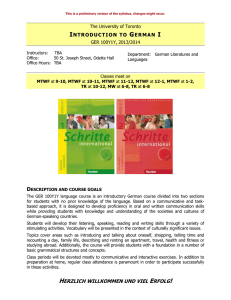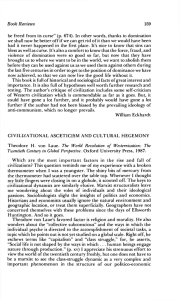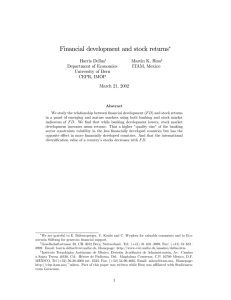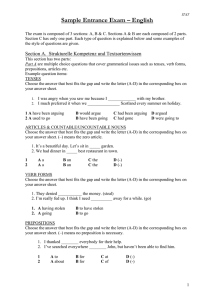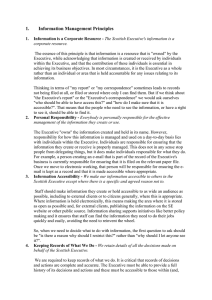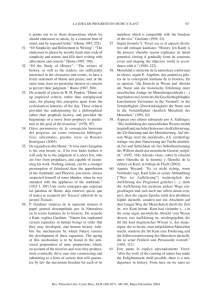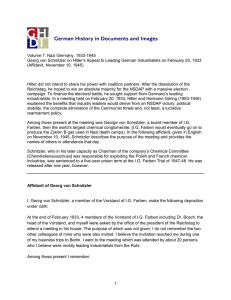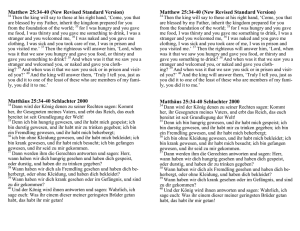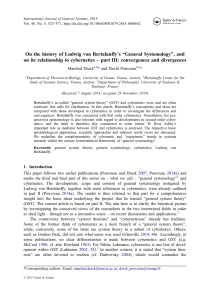The scholarly networks of Albrecht von Haller and
Anuncio
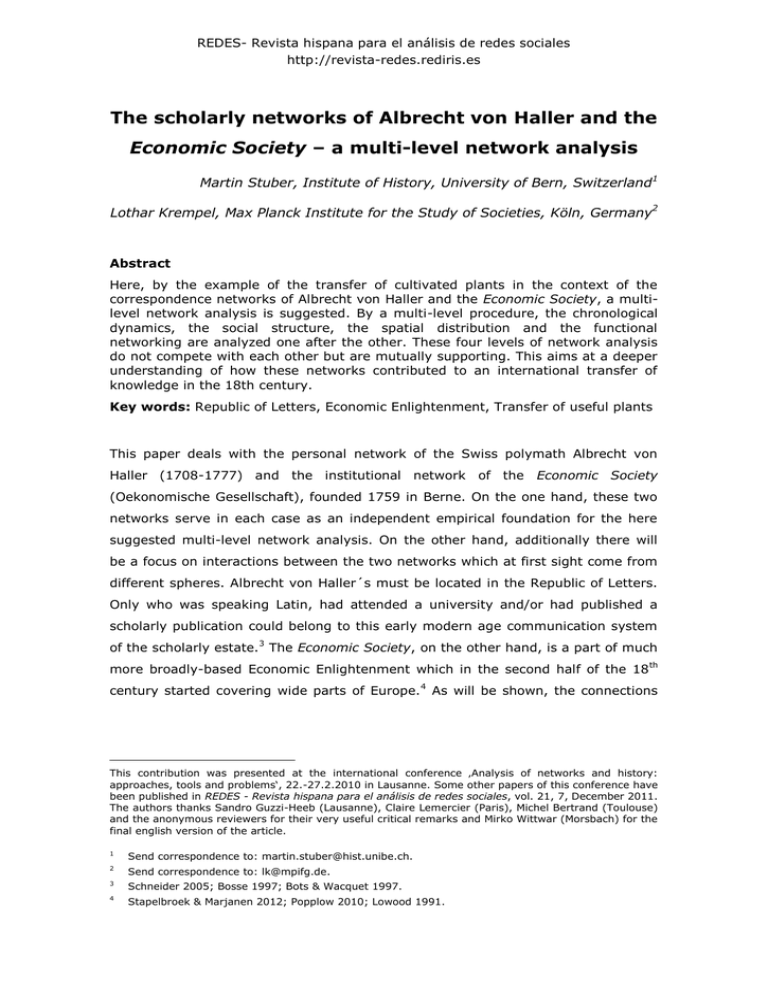
REDES- Revista hispana para el análisis de redes sociales http://revista-redes.rediris.es The scholarly networks of Albrecht von Haller and the Economic Society – a multi-level network analysis Martin Stuber, Institute of History, University of Bern, Switzerland1 Lothar Krempel, Max Planck Institute for the Study of Societies, Köln, Germany2 Abstract Here, by the example of the transfer of cultivated plants in the context of the correspondence networks of Albrecht von Haller and the Economic Society, a multilevel network analysis is suggested. By a multi-level procedure, the chronological dynamics, the social structure, the spatial distribution and the functional networking are analyzed one after the other. These four levels of network analysis do not compete with each other but are mutually supporting. This aims at a deeper understanding of how these networks contributed to an international transfer of knowledge in the 18th century. Key words: Republic of Letters, Economic Enlightenment, Transfer of useful plants This paper deals with the personal network of the Swiss polymath Albrecht von Haller (1708-1777) and the institutional network of the Economic Society (Oekonomische Gesellschaft), founded 1759 in Berne. On the one hand, these two networks serve in each case as an independent empirical foundation for the here suggested multi-level network analysis. On the other hand, additionally there will be a focus on interactions between the two networks which at first sight come from different spheres. Albrecht von Haller´s must be located in the Republic of Letters. Only who was speaking Latin, had attended a university and/or had published a scholarly publication could belong to this early modern age communication system of the scholarly estate.3 The Economic Society, on the other hand, is a part of much more broadly-based Economic Enlightenment which in the second half of the 18 th century started covering wide parts of Europe. 4 As will be shown, the connections This contribution was presented at the international conference ‚Analysis of networks and history: approaches, tools and problems‘, 22.-27.2.2010 in Lausanne. Some other papers of this conference have been published in REDES - Revista hispana para el análisis de redes sociales, vol. 21, 7, December 2011. The authors thanks Sandro Guzzi-Heeb (Lausanne), Claire Lemercier (Paris), Michel Bertrand (Toulouse) and the anonymous reviewers for their very useful critical remarks and Mirko Wittwar (Morsbach) for the final english version of the article. 1 Send correspondence to: [email protected]. 2 Send correspondence to: [email protected]. 3 Schneider 2005; Bosse 1997; Bots & Wacquet 1997. 4 Stapelbroek & Marjanen 2012; Popplow 2010; Lowood 1991. and overlappings of the Republic of Letters and Economic Enlightenment proved to be much more extensive than previously thought.5 In the following, at first we will give a short introduction to the central actors, comment on the historic sources this study is based on, and describe the data and the databases which underlie our analysis (1). Then two examples of networked cultural transfer will be sketched (2). On this basis, by a next step this will be abstracted into the various network representations, which should give an overall outline of the multi-level network analysis proposed here. This is meant to make obvious that the different dimensions of chronological dynamics, of the social structure, of spatial extension and of networking are mutually enlightening, supporting and extending (3). Main actors and data The first network describes the correpondence of Albrecht von Haller (fig.1). 6 After studying in Tübingen and Leiden he started practicing as a physician in his hometown of Berne. In 1736 Haller was appointed a professor of anatomy, botany and surgery at the newly established University of Göttingen. Besides botany, physiology became his main research activity. By conceptualizing physiology in a new way as an ‘animated anatomy’ he became an international scientific authority. In 1753 Haller went back to his homecountry to work as a director of the salt mines and later in the administration as a member of the Economic Committee and the Medical Council. Due to his multiple roles as an enlightened civil servant, author of essential treatises (on fodder plants, cereals and rinderpest) and as the president of the Bernese Economic Society, Haller was one of the central figures of Economic Enlightenment in Berne. 5 See also Brockliss 2002. 6 Steinke et al. 2008. 2 Figure 1. Albrecht von Haller (1708-1777), about 1760. – Burgerbibliothek Bern. The Economic Society in Berne (fig. 2) forms the second network to be analysed. 7 After predecessor organisations in Edinburgh (1723), Dublin (1731), Florence (1753), London (1754) and Rennes (1757), the founding of the Economic Society 1759 was followed by a real wave of founding such societies, which since the beginning of the 1760s started covering wide parts of Europe. Already contemporaries counted the Berne Society among the important institutions of Economic Enlightenment. This Europe-wide agricultural-economic reform movement aimed at generating useful knowledge with regard to economic and social reforms. The most important resources are new forms of networked communication, by which global knowledge and local experience come into closer contact with each other.8 7 Stuber et al. 2009. 8 Holenstein & Stuber & Gerber-Visser 2007. 3 Figure 2. Price medal of the Economic Society, 1763. - Historisches Museum Bern. Our analysis is empirically based on two several-years research projects on Albrecht von Haller and the Economic Society.9 The extensive data from both research projects have been standardised, homogenised and integrated into a combined database.10 While the typical study of historical correspondences documents communication partners of a single focus actor, such a simple egocentric transcription provides only limited insight into the social setting. Activities among all correspondents not mediated by the chosen focus remain undetected. The same holds true for the interaction between two such correspondence networks. These limitations, 9 Research project Albrecht von Haller und die Gelehrtenrepublik (<www.haller.unibe.ch>, Institute for the History of Medicine, University of Bern, headed by Urs Boschung): 1991-2003; Research project Nützliche Wissenschaft, Naturaneignung und Politik. Die Oekonomische Gesellschaft Bern im europäischen Kontext, 1750-1850 (<www.oeg.hist.unibe.ch>, Institute of History, University of Bern, headed by André Holenstein and Christian Pfister): 2004-2011. Both financed by the Swiss National Science Foundation. 10 Forschungsdatenbank zu Albrecht von Haller und zur Oekonomischen Gesellschaft Bern (location: Institute for the History of Medecine, Institute of History, Burgerbibliothek Bern); cf. Flückiger & Stuber 2009; Steinke 2003. 4 however, can be overcome when documenting the activities of multiple points of reference, allowing for a multipolar network perspective. Increasing the range of the study from an egocentric to that of a multipolar network perspective requires much more manpower than the individual perspective. The integration of different databases is a comparably cost efficient way to proceed to a more multipolar network view: storing information of networks A and B and the attibutes of their members and enriching these with additional affiliations allows to uncover both networks within their common environment and enhances our understanding of their interplay. Examples of networked transfer of useful plants To illustrate the surplus of this multipolar perspective, we present two examples which identify many overlaps and interactions of the activities in the personal network of Albrecht Haller and the institutional network of the Economic Society. Transfer of madder (Krapp) In 1764 Johann Rudolf Tschiffeli, founder of the Economic Society, read about a new technique for the processing of madder in the papers of the Société d’agriculture in Rouen.11 Tschiffeli might have received this article from Albrecht von Haller, since the Journal is found in Haller's library catalogue.12 The roots of madder - raw material for the production of red color - were of great commercial importance. Tschiffeli wrote to Louis-Alexandre Dambourney, a tradesman in Rouen and the author of the article, and asked him for advice and seeds. 13 Tschiffeli received both of these and read this letter to a meeting of the Economic Society and attempted to cultivate the seeds. 14 Shortly afterwards Dambourney received an honorary membership of the Economic Society.15 For his part, Tschiffeli acted on a suggestion from Dambourney and sought native types of madder. He wrote to Albrecht von Haller, whose botanical student Johann Jakob Dick assured him that madder are amongst the plants which occur naturally in the Wallis area. 16 As a 11 Following Stuber 2008a, pp. 252-263. 12 Dambourney 1763; Monti 1883-1994, Nr. 7412. 13 Tschiffeli 1765. 14 Abhandlungen und Beobachtungen durch die Oekonomische Gesellschaft zu Bern gesammelt, 1765, 1, p. IX-XXXV (VS 1764-02-23; VS 1764-05-05). 15 Abhandlungen und Beobachtungen durch die Oekonomische Gesellschaft zu Bern gesammelt, 1765, 1, p. IX-XXXV (VS 1764-03-10). 16 Letter from Tschiffeli to Haller, 28.1.1764 (Burgerbibliothek Bern). 5 result, Tschiffeli received roots and seeds of native varieties of madder, both from Haller and also from Haller’s correspondent Abraham-Louis Decoppet, a pastor in Aigle, as well as from Haller’s student Dick from Spiez, already mentioned above. 17 Then all these wild growing madder roots were presented at the meeting of the Economic Society in June 1765.18 On the basis of these multiple transfer processes Tschiffeli published comprehensive paper on madder in the journal of the Economic Society. 19 a This publication appeared two years later as an excerpt in the Rouen magazine, the place where Tschiffeli had started his endeavor 3 years ago. 20 This successful transfer unfolded simultaneously through the institutional communication channels of the Economic Society – meetings, letters, publications – and the private correspondence networks of Haller and Tschiffeli. The result was a new stock of knowledge which was obviously of supra-local relevance and needed only a short time to be succesfully applied commercially. In 1765 Tschiffeli could proudly announce that twelve families were already making a living out of his madder cultures on the Kleehof at Kirchberg. In 1767 he wrote to a friend that in that year alone he had sold more than 300 hundredweight. 1000 hundredweight were promised to various manufacturers for the following year.21 Transfer of carrot (Möhre) In July 1765 Peter Collinson, a businessman in London and one of the central players in global plant transfer of his time, sent Albrecht von Haller, his long time correspondent, a paper on the cultivation of carrots and their use as animal fodder.22 The author of the paper was Robert Billing, a farmer in Norfolk. He published it in the same year at the request of the London Society for the Encouragement of Arts, Manufactures and Commerce.23 In August 1765 a letter from their secretary was read out to the committee of the Economic Society, to 17 Tschiffeli 1765, pp. 154. 18 Abhandlungen und Beobachtungen durch die Oekonomische Gesellschaft zu Bern gesammelt, 1766, 1, V-XXVI (VS 1765-06-17). 19 Tschiffeli 1765. 20 Dambourney 1765. 21 Tschiffeli 1765. 22 Following Stuber 2008a, pp. 244-245; Letter from Collinson to Haller, 18.7.1765 (Burgerbibliothek Bern). 23 Billing 1765; see Monti 1983-1994, Nr. 900. 6 which the same paper was attached.24 In March 1766 the committee decided to translate this paper from English into French and German and to publish it in their journal, where it appeared as «Relation sur la culture des carottes jaunes» resp. «Nachricht von dem Anbaue der Möhren» in 1767.25 At the end of the same year the reverent Johann Jakob Gerwer from Vinelz sent a letter to the Economic Society – published a short time later – about his successful attempts at cultivating carrots, «for which Mr Billing’s paper gave not only the motivation but also the guidance». 26 An enthusiastic reader of both these publications was François-Joseph-Antoine de Hell, reeve of Upper Alsace and an honorary member of the Economic Society. In his letter, dated December 1768, he complained to the Economic Society that his carrots had not flourished as described in the Abhandlungen und Beobachtungen. He suspected his seeds to be a poorer variant than those used by Billing and Gerwer and asked the Berne society for appropriate seeds in return for payment. 27 The enquiry seems to have been forwarded straight to pastor Gerwer in Vinelz, because by January 1769 he had already answered it. In his parish he gave the order to procure sufficient quantities of carrot seeds, which he would then forward for the attention of Monsieur Hell.28 In March of the same year Gerwer was thus actually able to send the required seeds to Secretary Thormann. In his accompanying letter he wrote: «c’est tout que j’ai pu ramasser avec toutes les peines, que je me suis donné.» 29 And in turn they were forwarded promptly. Already in April 1769 Hell was able to thank the Berne society for the carrot seeds which had arrived just in time for sowing.30 Networked Transfer of Culture Both examples presented above can be interpreted in the context of the research paradigm of cultural transfer processes. While the study of these processes has for 24 Letter from Templeman to Oekonomische Gesellschaft, 24.8.1765v (Abhandlungen und Beobachtungen durch die Oekonomische Gesellschaft zu Bern gesammelt 1766, 1, p. XIX-XX). 25 Abhandlungen und Beobachtungen durch die Oekonomische Gesellschaft zu Bern gesammelt 1767, 1, p. XIII-XXIX (VS 1766-03-15); Billing 1767. 26 Letter from Gerwer to Oekonomische Gesellschaft, 31.12.1767 (Burgerbibliothek Bern): «Wozu Hrn. Billings Abhandlung nicht nur den Anlass, sondern auch die nöthige Anleitung gegeben.»; Gerwer 1768. 27 Letter from Hell to Oekonomische Gesellschaft, 12.12.1768 (Burgerbibliothek Bern). 28 Letter from Gerwer to Oekonomische Gesellschaft, 26.1.1769 (Burgerbibliothek Bern). 29 Letter from Gerwer to Oekonomische Gesellschaft, 15.3.1769 (Burgerbibliothek Bern). 30 Letter from Hell to Oekonomische Gesellschaft, 23.4.1769 (Burgerbibliothek Bern). 7 a long time been conceptualized as the exchange between at least two homogeneous spatial national cultures, a greater awareness of the variety and the network character of such interactions is encouraged by today's scholars. 31 In both cases – madder as well as carrot – the basic sequences of a cultural transfer (selection, transfer, reception) are found in different parts of the networks. The societies of Berne, Rouen and London and their publications turn out to be the platforms which organize, translate, multiply and sanction the activities of the individual actors. By help of both databases we can identify parts of a network that links the spheres of the Republic of Letters to Economic Enlightenment. Network representations The two concrete examples of the transfer of plants will now be related to the rather abstract levels of network analysis.32 By our approach of a multi-level network analysis we propose the simultaneous study of the chronological dynamics, the social structure, the spatial dimension and the cross-linking of the fields. The first parts of the analysis are in the tradition of Daniel Roche, who considered a correspondence network as a living organism; such an organism has a chronological beginning and end, features its own social and spatial structure and is interchangeable with many other such organisms. 33 For the analysis of the crosslinks we use more recent social science methods, namely network visualization procedures34 which we have already tested for their potential in another study. 35 Chronological dynamics The first analytical dimension is the temporal dynamics exhibited by both networks, which requires a deeper discussion of the completeness of the data available. We consider this to be particularly important, as not seldom historical network analysis is accused of ignoring both the chronological dimension and historical evidence. Altogether, Haller exchanged 16,981 letters with 1,138 male and 50 female correspondents and 11 institutions. While Haller received 13,237 letters from his 31 Reichardt 2003, pp. 28; see Lüsebrink 2001, pp. 213-226. 32 In the case of Albrecht von Haller the analysis can be supported by previous publications concerning time, social structure, space: Stuber & Hächler & Steinke 2005. The connections between the actors as presented by the initially given examples may be considered chains (see Grossetti & Barthe & Chauvac 2011). However, from the here taken point of view they can be identified as network actors contributing topically to the network activities at a certain time. 33 Roche 1971, pp. 151-172. 34 Krempel 2006. 35 Stuber & Hächler & Krempel & Ruisinger 2008. 8 correspondence partners, there are no more than 3,724 letters he sent himself, mainly due to the availibility of the records; in general one may expect Haller to have answered all of the letters. Accordingly, only letters received by Haller can be used for statistical analysis. Regarding these, we may assume to be provided with sufficient, but not at all with complete evidence. Sampling notes from his diary (1739, 1745 and 1746), where Haller had listed all incoming letters, allows us to assume the survival of almost two thirds of all letters. 36 During his early years, when Haller purposefully tried to establish a scientific correspondence network by traveling and offering services,37 the number of letters increased to about 60 letters received yearly. With his appointment in Göttingen, the number rose to 200 received letters. It peaked during the years 1752/53, with more than 500 letters, connected to the Europe-wide controversy about his theory of irritability (Irritabilität). After his return to Berne the number of letters stabilized on a high level, between 250 to 300 letters a year.38 The correspondence network of the Economic Society consists of much less letters. 1,044 letters to the Economic Society for the period 1759-1800 are available in the archive of the Burgerbibliothek Bern. From the meeting protocols we have reconstructed a further 792 (fig. 3), for which no documents are found in the archives. The temporal development reconstructed from the documents available can therefore be expected to closely reflect the historical activities, and we should not be surprised that the years of intense social activity in the 1760s and the early 1770s are also the years of intensive correspondence.39 36 Boschung 2002; Stuber (in print). 37 Stuber 2005. 38 Stuber & Hächler & Steinke 2005, pp. 65-84. 39 Stuber 2008b, pp. 126; Salzmann 2009. 9 Figure 3. Correspondence network of the Economic Society: Temporal development. – Stuber 2008b, pp. 127. Letters sent to the Economic Society, 1759-1800 (n=1836) 200 180 Evidence from records of meetings (792 letters) number of letters 160 140 120 Archive records (1044 letters) 100 80 60 40 20 1799 1797 1795 1793 1791 1789 1787 1785 1783 1781 1779 1777 1775 1773 1771 1769 1767 1765 1763 1761 1759 0 From this period of intense network activity of the Economic Society there date also the two initially quoted examples of the transfer of madder (1764-67) and of carrot (1765-69). For the period between 1759 and 1782 it is possible to reconstruct a total of 209 activities connected to the transfer of seeds, roots and seedlings, in most cases from letters directly addressing the Economic Society (143 cases), some from its treatises (21), from the records of meetings (21) as well as from letters to Haller (28).40 Also in the 1760s and 1770s, systematic inventories of useful plants were made in the environment of the Economic Society – and with Albrecht von Haller as a key-actor – 11 systematic inventories of plants relating about 650 different kinds to their local or global names.41 Networked cultural transfer, as it is illustrated by these examples, was based on such a translocal system of references. Social structure By a second step we look at the composition of the correspondence networks with the help of additional attributes. Doing so, the example of Haller´s correspondence network serves as an absolute feature (professional position), the network of the Economic Society, (membership). on the other hand, serves as a relational feature 42 40 Stuber 2008a, pp. 239. 41 Stuber & Lienhard 2007. 42 This disctinction while following Jansen 2006, pp. 51-54; see also the related analyses by René Sigrist on the networks of botanists in the 18th century, where the absolute features of network actors are focused on: Sigrist in print; on the other hand their relational features Sigrist & Widmer 2011. 10 Figure 4. Correspondence network of Albrecht von Haller: Social structure. - Stuber & Hächler & Steinke 2005, pp. 92. Positions held by Haller´s correspondents, weighed acc. to letters 1188 correspondents, 13226 letters surgeon, pharmacist: 37 corr., 276 letters (2.1%) book trade: 64 corr., 308 letters (2.3%) miscellaneous: 198 corr., 741 letters (5.6%) pastor, vicar: 72 corr., 406 letters (3.1%) physician: 286 corr., 4196 letters (31.7%) private person: 63 corr., 894 letters (6.8%) teacher: 103 corr., 1279 letters (9.7%) univ. prof. med.: 121 corr., 1448 letters (10.9%) univ. prof., scholar: 141 corr., 1515 letters (11.4%) statesman, magistrate, administration official: 193 corr., 2163 letters (16.2%) Figure 4 informs about the professions of the 1,188 correspondents, weighed according to the total of 13,226 letters they wrote to Albrecht von Haller. The most frequent professional category of the correspondents are physicians with 31%. To evaluate this result, additional networks are needed for which similar studies exist, for instance the networks of Esprit-Claude-François Calvet, Gotthold Ephraim Lessing, Jean-Jacques Rousseau und Christoph Jakob Trew. 43 Among these, the correspondence network of the physician and editor Trew from Nuremberg is, from a social perspective, the closest-knit one, since the medical communication dominates in both networks. While 72% of Trew's letters are addressed to medical personnel, this is true for 43% of Haller's letters. 16% of Hallers letters communicate with statemans, magistrates and administration officials, in contrast to Trew with only 8%. A high degree of communication with magistrates is also found in the network of Calvet, a physician from Avignon (14%). However, the bigger number of his letters are adressed to Catholic clerics (32%), apart from physicians and pharmacists with whom he exchanged 30% of his letters. The structure of Rousseau's network is completely different: only 3% are physicians, while Catholic priests and Protestant reverends receive 5% of his letters each. Predominant are his communications with the nobility, military officers and court 43 Brockliss 2002; Roche 1971; Bödeker 1987; Steinke 2000. 11 officials (36%). Another kind of network is that of Lessing, where we find 14% of the correspondence partners to come from the nobility and only 2% knowledgeable of natural sciences. The most important group of Lessing's correspondence partners are scholars (40%), like professors, educators and clerics, followed by writers, state officials (13%) and book publishers and printers (10%). 44 What are the conlucions that can be drawn from the social composition of these correspondence networks? Though the basis of our five examples may be too small for a rigid typology, the examples do allow for a rough orientation: Trew, Calvet and Haller are mainly a part of the Republic of Letters, whereas Rousseau and Lessing can be seen as a representative of a broader literate and enlightened public.45 Common to all the networks is, however, the high proportion of statemans, magistrates and administration officials, which indicates an overall embeddednes of the communication into the governmental structure. This is also illustrated by those actors contributing to the initially quoted transfer of useful plants in the context of Haller´s networks as being close to the state, such as the two state-salaried vicars Johann Jakob Dick and Abraham-Louis Decoppet as well as the administration officials Johann Rudolf Tschiffeli and the magistrate Albrecht von Haller. The type of memberships in addition to the professional status allows for a deeper understanding of the functional roles in the network. 46 One third of all letters were written to the Economic Society by honorary members, most of them international contacts. Correspondence partners without any formal institutional status in the Economic Society wrote another 30% of the letters, which indicates the open boundaries of this communication network. The fact that almost 20% of all letters were written by ordinary members remains to be explained, since these would have been able to articulate their concerns personally during the meetings of the society. The explanation is found in the organizational form of the Bernese administration which was grounded on the chronological mobility of the city patriciate, from whom most of the ordinary members were recruited. They had to rule for a six years period in the Bernese countryside. Their participation was therefore mostly in written form. 44 45 46 Stuber & Hächler & Steinke 2005, p. 90-92. The borders were but permeable: see for example Bensaude-Vincent & Bernardi 2003. Following Stuber 2008b, pp. 128-130. 12 Finally the 16% of letters from the local branches (Zweiggesellschaften) have to be mentioned. It was the constant information exchange with these local subsidiaries which were spread throughout the Bernese territory to fullfill the intended spatial transfer of knowledge. Many members of these branches were vicars living in the Bernese countryside. Among them there were Abraham-Louis Decoppet, Johann Jakob Dick und Jakob Gerwer, who had also played a role with the transfer of madder and carrots. Also the other actors appearing in the context of the initially mentioned examples of the transfer of useful plants may be counted among these groups, on the one hand, as ordinary members of the Economic Society, Albrecht von Haller, Johann Rudolf Tschiffeli and Victor Alex Thormann, on the other hand the international honorary members Louis-Alexandre Dambourney (Lyon), FrançoisJoseph-Antoine de Hell (Alsace) and Peter Templeman (London). Thus by their social structure, on the whole the actors of the plant transfer represent on the one hand the strong rootedness of Economic Enlightenment in local politics and administration, on the other in the international networking which was embodied by the honorary members.47 Spatial distribution Like Albrecht von Haller´s, the network of the Economic Society stretches from the Loire to the Oder, and both are also relatively well represented south of the Alps, in the British Isles and in Scandinavia (fig. 5). Both, the correspondence networks of Albrecht von Haller and that of the Economic Society, reveal a European dimension.48 Precisely this makes it different from other correspondence networks. An example of the non-European type is Rousseau’s correspondence network, which is essentially limited to France and French-speaking Switzerland and is only very marginally represented south of the Alps, east of the Rhine and in the British Isles. The same is true for the network of Christoph Jakob Trew which does not contain any locations west of the Rhine. 47 See Stuber 2012. 48 Following Stuber & Hächler & Steinke 2005, pp. 31-40; Stuber 2008b, pp. 126-127. 13 Figure 5. Correspondence network of the Economic Society. – Stuber 2008b, pp. 127. Also the plant transfer, which is in the fore here, was based on these large-scale networks. Even if only those network activities as being connected to plants are considered, precisely this European dimension can be stated both for Albrecht von Haller´s botanic correspondence49 and for the Economic Society´s transfer of useful plants.50 And also our initially quoted examples cover such an extended region. The foreign kind of carrots was transferred from the British Isles (Norfolk) to Alsace via Vinelz, the new way of growing and processing madder came from Lyon to Kirchberg near Berne, and in a modified way back to Lyon. Cross-linking Already the investigations by Holger Zaunstöck drew attention to the great importance of networking for the communications culture of the 18th century and particularly of the Enlightenment.51 That made it also obvious that one should not 49 Hächler 2008, pp. 201-218. 50 Stuber 2008b, pp. 240/241. 51 Zaunstöck & Meumann 2003; Zaunstöck 1999. 14 restrict oneself to the egocentric network which includes correspondence to the central institution only. The starting point must in fact be a multi-polar network which incorporates relationships and interactions with other correspondence networks. In addition to the network of Albrecht von Haller and that of the Economic Society, we have included another five correspondence networks into our database, all of them being well documented and sharing a botanical focus. These are the networks of Joseph Banks, Lorenz Heister, Carl von Linné, Jean-Jacques Rosseau and Christoph Jacob Trew.52 (fig. 6) In addition to the seven central figures, correspondents of all networks are shown who exchanged letters with at least tree of the central actors (fig. 7). Haller and Linné have the largest number of such connections – and are therefore mapped with the two largest circles in the image. Visualization is spatially organized according to the principle: strongly connected actors are organized next to each other, actors who are not conected or only by long paths are positioned in a distance to each other. A closer inspection reveals correspondents at the interface of the Republic of Letters and the Economic Enlightenment, for instance Vautravers, who exchanged letters with Rousseau, Banks, Linné, Haller and the Economic Society, or the famous agro-botanist Duhamel du Monceau, who exchanged with Linné, Haller and the Economic Society, as well as the Bernese magistrate and economist Samuel Engel, who was in correspondence with Haller, Linné and the Economic Society. Of the actors from the initially mentioned examples, apart from Haller only Peter Collinson is found in the visualization, who had indirect contacts to the Economic Society via Haller and exchanged letters with Linné and.Trew. However, we may not forget that this visualization must be read exclusively positively – regarding existent written correspondence – and not negatively, regarding missing written correspondence. Firstly, only written correspondence of the seven essential actors is represented, secondly a threshold value of at least three such relationships was fixed, thirdly only that written correspondence for which there exists historical evidence can be visualized. This threshold restriction has the consequence that, for example, Johann Jakob Dick, who appeared in the context of the madder example, is not found with this visualization. Indeed Dick is strongly networked, as he was corresponding with at least five other of the here mentioned correspondence partners (Michel Adanson, Petter Jonas Bergius, Johannes Gessner, Paul Dietrich Giseke, Johann Andreas Murray). But there is evidence only for two written correspondences with essential 52 Following Stuber & Hächler & Krempel & Ruisinger. 15 actors (Haller, Economic Society). However, most probably he also exchanged letters with Linné, as in the latter´s herbal we find no less than 30 pieces of plant evidence supplied by Dick. Figure 6. The dates of the correspondents. 168 169 170 171 172 173 174 175 176 177 178 179 180 181 182 0 0 0 0 0 0 0 0 0 0 0 0 0 0 0 Heister Trew Linné Haller Rousseau Banks Economi c Society While the first visualization depicts the direct relations among the authors of the letters, a second type to enhance the reconstruction of historical data is a twomode graph which describes the relations between two different sets of concepts. We use such a model to inspect the Bernese Reform Movement in greater detail (fig. 8). While still dealing with the authors of the letters (first set), we now use additional information about the affiliations of the correspondents with several social institutions (second set) which are essential for an understanding of the Berne society in the 18th century. These institutions are represented by colored codes in figure 8. Blue depicts the Grande Société as the social centre of the patriciate,53 yellow the Great Council and the Small Council as the political heart of the Berne Republic, green the Economic Society as the most powerful reform institution, white (on the right) the Helvetic Society (Helvetische Gesellschaft) as a nationwide Swiss institution for reform forces, 54 red the radical Société des Citoyens,55 and violet the correspondence network of Albrecht von Haller, restricted to his correspondence partners from Berne, Aargau and Vaud. If two actors are attached to exactly the same group, they can make contact to each other by two steps. If this is the only information available about them, they cannot be distinguished on a relational basis: they are equivalent. Actors who are 53 Tscharner 1909; Brunner 2009. 54 Im Hof & Capitani 1983. 55 Knill 1993. 16 members of several institutions are placed in the center of gravity of all to which they are connected. Likewise, two organisms are placed close to each other if they have a strong overlap in composition of their actors, respectively distant from each other if they have no or very small overlapping memberships. Of the total of 392 actors, however, due to space constraints only those 188 are illustrated who feature at least two relationships. In the left part of the image all actors are found who have no link to any of the various reform societies. Here we find the 20 Council members who are uniquely linked to Haller’s correspondence and another 49 Council members who belong just to the Grande Société, as well as 7 actors who belong to just these three but not to any of the reform societies. In contrast, those actors who are connected with both the political and the social elite and also with the reform societies are found in the centre of the drawing. The brothers Vinzenz Bernhard Tscharner and Niklaus Emanuel Tscharner have the largest number of all affiliations (6 connections each), followed by other very active members of the Economic Society with 5 relationships each.56 More to the right we find actors without any direct connections to the institutional centres of the political and social elite of the Berne Republic. Among these are Johann Georg Zimmermann and Georg Ludwig from Auenstein, who do not belong to the Berne patriciate because they originate from Brugg. Both played a central role in the Berne reform movement. An interesting class of structurally equivalent actors is depicted by the green-red symbols: members of the Economic Society exchanging letters with Albrecht von Haller; most of them are physicians, pharmacists and clerics, communicating as botanic assistants with Haller and the Economic Society. In the same region we find a number of residents of the Vaud, who are connected in the same way to the Bernese reform movement through Haller and the Economic Society, such as Loys de Chessaux, Seigneux de Correvon, 56 Karl Emanuel Bonstetten and Alexander von Wattenwyl, the two Presidents of the Economic Society and active members Emanuel von Graffenried and Franz Jakob von Tavel. Christoph Steiger and Niklaus Steiger are two actors with more than five links who are placed in the center but showed only minor activities in the Economic Society. 17 Figure 7. Visualization A:. Correspondence networks of botanists in the 18th century – Stuber, Hächler, Krempel & Ruisinger (2008. pp. 352. [Click on the image to enlarge] Figure 8. Visualization B: Bernese reform movement 1765. [Click on the image to enlarge] Tissot and also Madame Vicat-Curtat. This last group involves all Lausanners. Focusing on the spatial dimension, this becomes obvious: the locations of Waadtland are mostly connected to the correspondence network of the Economic Society (fig. 5): Orbe (26 letters), Morges (29), Cottens (41), Nyon (56), Yverdon (57), Vevey (114) and – in first place – Lausanne (190). Also with this visualization we may ask about the positions of the actors of the initially mentioned examples. Albrecht von Haller as a member of the Grand 18 Council, President of the Economic Society and an essential figure of a Europe-wide correspondence network – which in our depiction is restricted to its Bernese part – is located in the center. Also in the center is Johann Rudolf Tschiffeli. In contrast to Haller, however, he does not belong to the political power (Grand Council), but to the center of society (Grande Société) as well as to the two political reform societies, Société des citoyens and Helvetic Society. Johann Jakob Dick, on the other hand, is represented neither in the political nor the social center, and also he does not belong to the two mentioned reform societies (he thus appears at the upper fringe to the right). Conclusions What do we gain from such a multi-levelled network analysis concerning our understanding of the transfer of useful plants and the thus connected knowledge transfer in the 18th century? First of all, there is the possibility to classify the initially mentioned examples according to the overall context. The basic question, if these are exemplary cases or exceptions, can be differentiated according to the various here presented dimensions – chronologically, spatially, socially, functionally. Just as the transfer of the carrots, also that of the madder happened at a time when the two networks were at their peak. Their Europe-wide dimension becomes obvious particularly in the case of the transfer of the carrots, covering three language areas (German, English, French). As important hinges to other spaces there served honorary memberships by help of which the Economic Society became internationally networked, as it was the case also with the two initially mentioned examples. Socially, a number of actors came from a milieu which was close to the state (magistrates, administration officials, vicars), which is in accordance to the basic feature of Economic Enlightenment. The increased transfer of useful plants as well as of thus connected knowledge counted among the essential activities of this movement. A precondition for cross-spatial exchange was a concordance of local, regional and global plant names, which could only be provided by scientific botany. The most obvious interface with the Republic of Letters was Albrecht von Haller, who played an essential role with botany in those days. However, the agricultural-economic reform movement was connected to the Republic of Letters also via Vicar Dick and the merchant Collinson, both of whom were in intensive written correspondence with scholarly botanists. The reconstructed action chains of the plant transfer connect actors from socially very much different groups. Among others, this becomes manifest precisely at the local level. With Haller, a member of the magistrate participated in the transfer of 19 the madder, with Tschiffeli there was a member of the social center and the political reform groups, as well as with Dick a representative of the intellectuals without any active political rights whatsoever. Multi-levelled network analysis makes us more aware of spatial, social and functional closeness and distance between actors. One of the common objections concerning the usefulness of historical network studies is their abstraction from geographical space and time, while statistical aggregations of historical data in form of time series, diagrams and maps provide a systems view only, ignoring the individual perspective. By combining both perspectives in our study of a multi-level network analysis we have demonstrated how to overcome these shortcomings. Instead of interpreting the various dimensions of the networks as alternative explanations, it is especially their combination which enhances our understanding of how these networks contributed to the transfer of knowledge. References Bensaude-Vincent, Bernadette & Bernardi, Bernard (2003). Rousseau et les sciences. Paris 2003: Editions L'Harmattan. Billing, Robert (1765), An account of the culture of carrots and their great use in feeding and fattening cattle, published by desire of the Society for the Encouragement of Art, Manufactures, and Commerce at London. London: J. Dodsley. Billing, Robert (1767), „Nachricht von dem Anbaue der Möhren, Daucus Sativus“ en Abhandlungen und Beobachtungen durch die Oekonomische Gesellschaft zu Bern gesammelt, 2, pp. 129-155. Bödeker, Hans Erich (1987). „Lessings Briefwechsel“ en Hans Erich Bödeker & Ulrich Hermann. Über den Prozess der Aufklärung in Deutschland im 18. Jahrhundert. Personen, Institutionen und Medien. Göttingen: Vandenhoeck & Ruprecht, pp. 113-138. Boschung, Urs et al. (2002). Repertorium zu Albrecht von Hallers Korrespondenz 1724-1777, 2 vols. Basel: Schwabe. Bosse, Heinrich (1997). „Die gelehrte Republik“ en Hans-Wolf Jäger. ‘Öffentlichkeit’ im 18. Jahrhundert. Göttingen: Vandenhoeck & Ruprecht, pp. 51-76. Bots, Hans & Wacquet, Françoise (1997). La République des Lettres. Berlin: De Boeck. 20 Brockliss, Laurence W.B (2002), Calvet’s Web. Enlightenment and the Republic of Letters in Eighteenth-Century France. Oxford: University Press. Brunner, Franz C. et al. (2009), Hôtel de Musique und Grande Société in Bern 1759-2009. Murten: Licorne. Dambourney, Louis-Alexandre (1763). „Mémoire sur la culture de la garance”. Délibérations et mémoires de la Société Royale de l’agriculture de la généralité de Rouen, 1, pp. 241-274. Dambourney, Louis-Alexandre (1767), „Extrait du mémoire sur la culture de la garance, présenté à la Société de Berne, en Février 1765, par Monsieur Tschiffely“. Délibération et mémoires de la généralité de Rouen, pp. 269-301. Dauser, Regina et al. (2008), Wissen im Netz. Botanik und Pflanzentransfer in europäischen Korrespondenznetzen des 18. Jahrhunderts. Berlin: Akademie Verlag. Flückiger, Daniel & Stuber, Personenorientierte Martin Datenbanken (2009), für „Vom Archiv und System zum Forschung“ Akteur. en André Kirchhofer et al., Nachhaltige Geschichte. Festschrift für Christian Pfister. Zürich: Chronos, pp. 253-269. Gerwer, Johann Jakob (1768), „Versuch in Anbauung der gelben Möhren“. Abhandlungen und Beobachtungen durch die Oekonomische Gesellschaft zu Bern gesammelt, 1, pp. 70-75. Grossetti, Michel & Barthe, Jean-François & Chauvac, Nathalie (2011), „Studying Relational Chains from Narrative Material”. Bulletin de Méthodologie Sociologique 110, pp. 11-25. Hächler, Stefan (2008), „Avec une grosse boete de plantes vertes – Pflanzentransfer in der Korrespondenz Albrecht von Hallers (1708-1777)“ en Regina Dauser et al. (2008), Wissen im Netz. Botanik und Pflanzentransfer in europäischen Korrespondenznetzen des 18. Jahrhunderts. Berlin: Akademie Verlag, pp. 201-218. Holenstein, André & Stuber, Martin & Gerber-Visser, Gerrendina (2007). Nützliche Wissenschaft und Ökonomie im Ancien Régime. Akteure, Themen, Kommunikationsformen. (Cardanus Jahrbuch für Wissenschaftsgeschichte, 7). Heidelberg: Palatina. Im Hof, Ulrich & Capitani, François (1983), Die Helvetische Gesellschaft. Spätaufklärung und Vorrevolution in der Schweiz. 2 vols. Frauenfeld: Huber. 21 Jansen, Dorothea (2006), Einführung in die Netwerkanalyse. Wiesbaden: UTB (3. überarb. Aufl.). Knill, Ivo (1993), Die Société des citoyens und die Oekonomische Gesellschaft als Trägerinnen der Aufklärung in Bern. Bern: Lizentiatsarbeit Institut für Germanistik Univ. Bern. Krempel, Lothar (2005), Visualisierung komplexer Strukturen. Grundlagen der Darstellung mehrdimensionaler Netzwerke. Frankfurt & New York: Campus. Lowood, Henry E. (1991), Patriotism, Profit and the Promotion of Science in the German Enlightenment. The Economic Scientific Societies 1760-1815. New York & London: Univ. of California. Lüsebrink, Hans-Jürgen (2001), „Kulturtransfer – methodisches Modell und Anwendungsperspektiven“ en Ingeborg Tömmel, Europäische Integration als Prozess von Angleichung und Differenzierung. Opladen: Leske & Budrich, pp. 213-226. Monti, Maria Teresa (1983-1994), Catalogo del Fondo Haller della Biblioteca Nazionale Braidense di Milano, 13 voll. Milano: Franco Angeli. Popplow, Marcus (2010), Landschaften agrarisch-ökonomischen Wissens. Strategien innovativer Ressourcennutzung in Zeitschriften und Sozietäten des 18. Jahrhunderts. Münster et al.: Waxmann. Reichardt, Rolf (2003), „Arbeitsperspektiven zur interkulturellen Kommunikation zwischen Ancien Régime und Moderne“ en Thomas Fuchs & Sven Trakulhun, Das Eine Europa und die Vielfalt der Kulturen. Kulturtransfer in Europa 15001850. Berlin: Berliner Wissenschaftsverlag, pp. 27-46. Roche, Daniel (1971), „Les primitifs du Rousseauisme: une analyse sociologique et quantitative de la correspondance de J.J. Rousseau.” Annales 26, pp. 151-172. Salzmann, Daniel (2009) Dynamik und Krise des ökonomischen Patriotismus. Das Tätigkeitsprofil der Oekonomischen Gesellschaft Bern 1759-1797. Nordhausen: Traugott Bautz. Schneider, Ulrich Johannes (2005): Kultur und Kommunikation. Die europäische Gelehrtenrepublik im Zeitalter von Leibniz und Lessing. Wolfenbüttel: Harrassowitz. Sigrist, René & Widmer, Eric D. (2011), „Training links and transmission of knowledge in 18thCentury botany: a social network analysis”. REDES – Revista hispana para el análisis de redes sociales, 21, 7, pp. 347-387. 22 Sigrist, René (in print), „On the Social Characteristics of the 18th Century Botanists” en André Holenstein & Hubert Steinke & Martin Stuber (in print), Scholars in Action. The Practice of Knowledge and the Figure of the Savant in the 18th Century. Leiden et al.: Brill. Stapelbroek, Koen & Marjanen, Jani (2012), The Rise of Economic Societies in the Eighteenth Century: Patriotic Reform in Europe and North America. Gordonsville: Palgrave Macmillan. Steinke, Hubert (2000), Der nützliche Brief. Die Korrespondenz zwischen Albrecht von Haller und Christoph Jakob Trew 1733-1763, Basel: Schwabe. Steinke, Hubert (2003): „Archive database as advanced research tools: the HallerProject” en Maria Teresa Monti, Antonio Vallisneri. L’edizione del Testo scientifico d’età moderna. Firenze: L.S. Olschki, pp. 191-204. Steinke, Hubert et al. (2008), Albrecht von Haller – Leben, Werk, Epoche. Göttingen: Wallstein. Stuber, Martin & Hächler, Stefan & Steinke, Hubert (2005), „Albrecht von Hallers Korrespondenz. Eine Gesamtanalyse“ en Martin Stuber & Stefan Hächler & Luc Lienhard, Hallers Netz. Ein europäischer Gelehrtenbriefwechsel zur Zeit der Aufklärung. Basel: Schwabe, pp. 3-216. Stuber, Martin & Lienhard, Luc (2007), „Nützliche Pflanzen. Systematische Verzeichnisse von Wild- und Kulturpflanzen im Umfeld der Oekonomischen Gesellschaft Wissenschaft Bern und 1762-1782“ Ökonomie en im André Holenstein Ancien Régime. et al., Nützliche Akteure, Themen, Kommunikationsformen. (Cardanus Jahrbuch für Wissenschaftsgeschichte, 7). Heidelberg: Palatina, pp. 65-106. Stuber, Martin (2005), „Brief und Mobilität bei Albrecht von Haller. Zur Geographie einer europäischen Gelehrtenkorrespondenz“ en Johannes Burkhardt & Christine Werkstetter, Kommunikation und Medien in der Frühen Neuzeit (Historische Zeitschrift, Beiheft 41). München: Oldenbourg, pp. 313-334. Stuber, Martin & Hächler, Stefan & Krempel, Lothar & Ruisinger, Marion Maria (2008), „Exploration von Netzwerken durch Visualisierung. Die Korrespondenznetze von Banks, Haller, Heister, Linné, Rousseau, Trew und der Oekonomischen Gesellschaft Bern“ en Regina Dauser et al. (2008), Wissen im Netz. Botanik und Pflanzentransfer in europäischen Korrespondenznetzen des 18. Jahrhunderts. Berlin: Akademie Verlag, pp. 347-374. 23 Stuber, Martin (2008a), „Kulturpflanzentransfer im Netz der Oekonomischen Gesellschaft Bern“ en Regina Dauser et al., Wissen im Netz. Botanik und Pflanzentransfer in europäischen Korrespondenznetzen des 18. Jahrhunderts. Berlin: Akademie Verlag, pp. 229-269. Stuber, Martin (2008b), „Das Korrespondenznetz der Oekonomischen Gesellschaft Bern, 1759-1800“ en Ulrich Johannes Schneider, Kulturen des Wissens im 18. Jahrhundert. Berlin & New York: Walter de Gruyer, pp. 123-132. Stuber, Martin et al. (2009), Kartoffeln, Klee und kluge Köpfe. Die Oekonomische und Gemeinnützige Gesellschaft des Kantons Bern OGG (1759-2009). Bern et al.: Haupt. Stuber, Martin (2012), „Die Oekonomische Gesellschaft Bern als Kontaktzone im europäischen Austausch agrarisch-ökonomischen Wissens“ en Regina Dauser & Lothar Schilling, Grenzen und Kontaktzonen. Rekonfigurationen von Wissensräumen zwischen Frankreich und den deutschen Ländern 1700–1850. discussions 7 (www.perspectivia.net). Stuber, Martin (in print), „Le réseau de correspondance d’Albert de Haller. Formation, perception, réception“ en Jean Boutier & Emmanuelle Chapron, Conserver, archiver, éditer. Usages de la correspondance savante, XVIIeXVIIIe siècles. Tscharner, Louis de (1909), La Grande Société de Berne 1759-1909. Notice commémorative à l’occasion du cent cinquantième anniversaire de sa fondation. Bern: Stämpfli. Tschiffeli, Johann Rudolf (1765), „Abhandlung vom Anbau der Färber-Röthe, oder des Grapps“. Abhandlungen und Beobachtungen durch die Oekonomische Gesellschaft zu Bern gesammelt, 2, pp. 135-162. Zaunstöck, Holger (1999), Sozietätslandschaft und Mitgliedstrukturen. Die mitteldeutschen Aufklärungsgesellschaften im 18. Jahrhundert. Tübingen: Max Niemeyer. Zaunstöck, Holger & Meumann, Markus (2003), Sozietäten, Netzwerke, Kommunikation. Neue Forschungen zur Vergesellschaftung im Jahrhundert der Aufklärung. Tübingen: Max Niemeyer. 24
